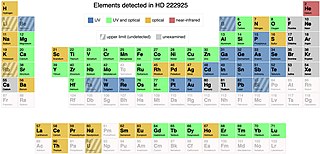
KNOWPIA
WELCOME TO KNOWPIA
Summary
HD 222925 is a horizontal branch star about 1,470 light years away in the southern constellation Tucana. It is magnitude 9, far below naked-eye visibility. It is an Ap star, a type of chemically peculiar star with an over-abundance of certain metals in its spectrum.
 Elements detected in HD 222925 totalling 65 with 42 coming from the r-process (31 ≤ Z ≤ 92) . Elements with no long-lived isotopes are indicated using the light gray font.[1] | |
| Observation data Epoch J2000.00 Equinox J2000.00 | |
|---|---|
| Constellation | Tucana |
| Right ascension | 23h 45m 17.607s[2] |
| Declination | −61° 54′ 42.84″[2] |
| Apparent magnitude (V) | 9.03[3] |
| Characteristics | |
| Evolutionary stage | horizontal branch |
| Spectral type | F8 Sr Eu[4] (ApSrEu)[5] |
| Astrometry | |
| Radial velocity (Rv) | −38.9±0.6[6] km/s |
| Proper motion (μ) | RA: 143.803[2] mas/yr Dec.: −99.109[2] mas/yr |
| Parallax (π) | 2.2202 ± 0.0117 mas[2] |
| Distance | 1,469 ± 8 ly (450 ± 2 pc) |
| Details | |
| Mass | 0.75±0.20[6] M☉ |
| Radius | 6[7] R☉ |
| Luminosity | 43[4] L☉ |
| Surface gravity (log g) | 2.54±0.17[1] cgs |
| Temperature | 5,636±103[1] K |
| Metallicity [Fe/H] | −1.47±0.08[6] dex |
| Other designations | |
| Database references | |
| SIMBAD | data |
HD 222925 has been referred to as the 'gold standard star' by the media.[8] In 2022, astronomers from the University of Michigan identified 65 elements in the star (including gold), a turning point to help the scientific community understand the rapid neutron capture process.[9] The elements were produced in a massive supernova or a merger of neutron stars early in the universe, and it was ejected into space where it later reformed into the current star.[10]
Gallery edit
References edit
- ^ a b c d Roederer, Ian U.; Lawler, James E.; Den Hartog, Elizabeth A.; Placco, Vinicius M.; Surman, Rebecca; Beers, Timothy C.; Ezzeddine, Rana; Frebel, Anna; Hansen, Terese T.; Hattori, Kohei; Holmbeck, Erika M.; Sakari, Charli M. (2022). "The R-process Alliance: A Nearly Complete R-process Abundance Template Derived from Ultraviolet Spectroscopy of the R-process-enhanced Metal-poor Star HD 222925". The Astrophysical Journal Supplement Series. 260 (2): 27. arXiv:2205.03426. Bibcode:2022ApJS..260...27R. doi:10.3847/1538-4365/ac5cbc. S2CID 248571656.
- ^ a b c d e Brown, A. G. A.; et al. (Gaia collaboration) (2021). "Gaia Early Data Release 3: Summary of the contents and survey properties". Astronomy & Astrophysics. 649: A1. arXiv:2012.01533. Bibcode:2021A&A...649A...1G. doi:10.1051/0004-6361/202039657. S2CID 227254300. (Erratum: doi:10.1051/0004-6361/202039657e). Gaia EDR3 record for this source at VizieR.
- ^ Bailer-Jones, C. A. L.; et al. (2011). "Bayesian inference of stellar parameters and interstellar extinction using parallaxes and multiband photometry". Monthly Notices of the Royal Astronomical Society. 411 (1): 435–452. arXiv:1009.2766. Bibcode:2011MNRAS.411..435B. doi:10.1111/j.1365-2966.2010.17699.x. S2CID 30425562.
- ^ a b Cunha, M. S.; et al. (2019). "Rotation and pulsation in Ap stars: First light results from TESS sectors 1 and 2". Monthly Notices of the Royal Astronomical Society. 487 (3): 3523. arXiv:1906.01111. Bibcode:2019MNRAS.487.3523C. doi:10.1093/mnras/stz1332.
- ^ Houk, Nancy (1975). Michigan catalogue of two-dimensional spectral types for the HD stars. Vol. 1. Ann Arbor, Michigan: Dept. of Astronomy, University of Michigan. Bibcode:1975mcts.book.....H.
- ^ a b c Roederer, Ian U.; Sakari, Charli M.; Placco, Vinicius M.; Beers, Timothy C.; Ezzeddine, Rana; Frebel, Anna; Hansen, Terese T. (2018). "The R-Process Alliance: A Comprehensive Abundance Analysis of HD 222925, a Metal-poor Star with an Extreme R-process Enhancement of [Eu/H] = -0.14". The Astrophysical Journal. 865 (2): 129. arXiv:1808.09469. Bibcode:2018ApJ...865..129R. doi:10.3847/1538-4357/aadd92. S2CID 119046070.
- ^ Cruzalèbes, P.; Petrov, R. G.; Robbe-Dubois, S.; Varga, J.; Burtscher, L.; Allouche, F.; Berio, P.; Hofmann, K. H.; Hron, J.; Jaffe, W.; Lagarde, S.; Lopez, B.; Matter, A.; Meilland, A.; Meisenheimer, K.; Millour, F.; Schertl, D. (2019). "A catalogue of stellar diameters and fluxes for mid-infrared interferometry". Monthly Notices of the Royal Astronomical Society. 490 (3): 3158–3176. arXiv:1910.00542. Bibcode:2019MNRAS.490.3158C. doi:10.1093/mnras/stz2803. S2CID 203610229.
- ^ "Astronomers find 'gold standard' star in Milky Way". University of Michigan News. 2022-05-10. Retrieved 2022-05-18.
- ^ Sherburne, Morgan; Michigan, University of. "Astronomers find 'gold standard' star in Milky Way". phys.org. Retrieved 2022-05-18.
- ^ Science, Carnegie (2022-05-13). "Astronomers find 'gold standard' star in Milky Way". Carnegie Institution for Science. Archived from the original on 2022-05-13. Retrieved 2022-05-18.
- ^ "Gemini's GHOST Captures Exquisite First Light Observations of a Bright, Chemically Rich Star". Retrieved 16 December 2022.
External links edit
- Hensley, Kerry (2023-07-26). "Making Sense of the Many Metals in HD 222925's Spectrum". AAS Nova.


